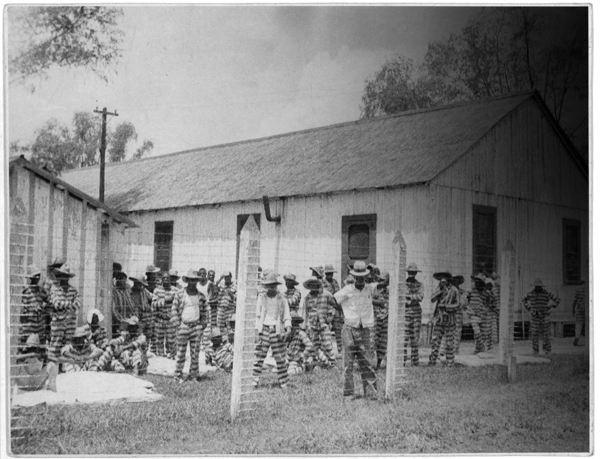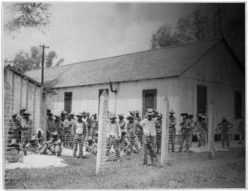Louisiana State Penitentiary at Angola
Founded in the early nineteenth century during a time of radical penal reformation, the Louisiana State Penitentiary at Angola is one of the nation's largest prisons.

Courtesy of Library of Congress Prints and Photographs Division.
This 1934 photograph of Angola prisoners, taken by folklorist Alan Lomax, features Huddie “Lead Belly” Ledbetter in the foreground. Imprisoned for attempted homicide, Lead Belly was released later that year.
Founded in the early nineteenth century during a time of radical penal reformation, the Louisiana State Penitentiary at Angola is one of the nation’s largest prisons. Although the penitentiary’s original plan focused on prisoner rehabilitation, over time the prison garnered a reputation for brutal treatment of inmates and unhygienic facilities. In recent decades, however, Angola has instituted many reforms and undergone dramatic change.
Creation of Louisiana’s Penal System
Soon after Louisiana gained statehood in 1812, Edward Livingston, a lawyer and politician from New York, was commissioned to sort out the unique tangle of legal codes resulting from Louisiana’s history first as a colony of France, then of Spain, and finally, a territory of the United States. By 1824, Livingston had produced a civil code, a code of procedure, a commercial code, and—his most prized accomplishment—his System of Penal Law. He aimed not only to unscramble the state’s criminal code but also to build into it incentives to prevent crime and reform offenders, a system based on Enlightenment philosophy. Livingston’s “Code of Reform and Prison Discipline” within the System of Penal Law called for prisoners to receive education and vocational training; he believed that career criminals should be housed separately from other inmates, and minors ought to be held in a separate facility. The state’s General Assembly did not share Livingston’s vision, however, and adopted only his civil code and code of procedure, ignoring the System of Penal Law entirely and setting aside any notion of prison reform.
From the time that Louisiana entered the Union, state prisoners were held in a New Orleans jail. In 1819, Governor Jacques Villeré first called for a penitentiary to be built so that those imprisoned as debtors would not be confined with violent criminals. In 1835, the state finally constructed a penitentiary in Baton Rouge, at the intersection of Sixth and Laurel Streets. In an attempt to cultivate a facade of civility, the new penitentiary was modeled after Connecticut’s Wethersfield prison, a state-of-the-art facility at the time.
Convict Lease System
During the years the penitentiary was bankrolled by the state, 1830 to 1844, the legislature found the prison expensive to operate and sought alternative methods to finance its operation. Modeling Kentucky’s solution to high prison costs, Louisiana resorted to convict leasing and turned the penitentiary over to McHatton, Pratt and Company, a private firm.
This profit motive led to hideous abuses against inmates, as lessees sought to extract the maximum amount of labor from prisoners while spending the minimum on their sustenance. Except for two brief periods—an interlude between leases in the 1850s and during the Civil War—Louisiana’s prisoners would remain under private control until 1901. The most infamous lessee, Major Samuel James, held the contract with the state for more than thirty years, beginning in 1867. James turned a profit using prisoners as workmen on Mississippi River levees and as farmhands at his West Feliciana Parish plantation named Angola. Convicts were used, in essence, as legal slave labor after slavery was abolished. By 1901 the public demanded a change in the lease system, and the state took over again.
Twentieth-Century Struggles and Reform
In 1900 Major James sold the 8,000 acres of Angola to the state for $200,000, and the plantation became a working farm site of Louisiana’s state penitentiary. The original penitentiary building in Baton Rouge was demolished in 1918.
After the state resumed control of the penitentiary and its prisoners in 1901, the Department of Corrections was placed under the jurisdiction of the Board of Control, a panel named by the governor of Louisiana. Under the board’s oversight, conditions for inmates improved considerably, but the floods of 1903 and 1912 threatened the economic viability of Angola’s farm output.
In 1916 the Board of Control was replaced with a general manager, Henry L. Fuqua; he maintained his post until 1923. Fuqua’s objective was to create a self-sustaining penal system. To save money, one of the first changes he made was to replace guards with trusted inmates. The “trusty guard” system was highly criticized but nevertheless utilized for decades. Fuqua spent the first six years of his term extricating Louisiana’s penal system from a financial morass primarily caused by flooding. But in 1922, another flood hit Angola, destroying crops and undoing the financial successes of Fuqua’s administration. He was, however, able to purchase 10,000 acres from neighboring planters who gave up on the flood-prone land, thereby increasing Angola’s area to its current size of approximately 18,000 acres.
Governor Huey P. Long dominated Louisiana politics from 1928 to 1935, and although he rose to power as a populist, his attitude about the penal system was that of a capitalist. He saw the penitentiary as a business enterprise that was to be self-sustaining. During the Great Depression, hard times were particularly felt at Angola, as Long’s administration was reticent to appropriate any funding for the prison. In a period when large segments of society were suffering, the misery of convicts in a remote location did not draw much attention from the public. As a result, long hours of convict work and brutal flogging practices reappeared while the prison administration attempted to maintain self-sufficiency.
By the mid-1940s, Angola had fallen into notoriously sordid conditions. Governor Jimmie Davis admitted the need for improvements; in 1945 he hired federal penologists to conduct studies of the facilities. The results condemned the “trusty guard” system and stated that the sanitary conditions were deplorable. Davis recommended a reformation of the penitentiary system, at a considerable cost. Implementation was slow. During the administration of Governor Earl Long, Angola received a budget increase intended for facility improvements, construction, and levee repairs. But in spite of the modest efforts by the state, Angola’s overall condition remained in disarray, and whippings of inmates actually increased.
In 1951, thirty-one inmates slashed their Achilles tendons in a protest against their inhumane living conditions and the brutal work schedule; they were called “The Heel String Gang” because of their desperate act. Collier’s magazine ran an article about the protest, calling Angola “America’s Worst Prison.” In response to public outcry, Robert Kennon based his successful campaign for governor largely on promises of massive reform. After Kennon’s election, he spearheaded an increase in Angola’s operating budget, enabling prison officials to hire new civilian guards and draw up major construction plans. Also, modernization of prisoner categorization was acted upon, female inmates were moved to a separate camp in St. Gabriel, and plans for a first-offender correctional institution were authorized.
A fiscal crisis in 1962 hindered reforms at Angola. Over the ensuing years, the prison garnered the reputation for being “the bloodiest prison in the South.” Stabbings were common: forty inmates were murdered between 1972 and 1975. In the early 1970s, four inmates sued the state for violation of their civil rights due to the barbaric conditions and poor supervision of the inmates and facilities. The case led to federally mandated reforms. During the same period, in 1972, Governor Edwin Edwards hired Elayn Hunt as Director of Corrections. Hunt was responsible for the oversight of major reforms, which included the final end of the “trusty guard” system. The security staff was doubled and new camps were constructed. Within two years of the federal mandate, in 1977, inmate violence plummeted and the violent death rate dropped to zero.
Ross “Boss Ross” Maggio became warden of Angola in 1976. Under his watch, the cleanup continued. His years were marked by tight security and a dedication to hard inmate labor. In 1990, John Whitley was appointed warden of Angola. His tenure was marked by an emphasis on rehabilitation programs.
By 1994, Angola qualified for accreditation from the American Correctional Association. Accreditation signifies a healthy environment for prisoners and employees, both physically and legally. In the first decade of the twenty-first century, Angola’s reform continued under Warden Burl Cain, who took charge of the prison in 1995, and Richard L. Stalder, Secretary of Louisiana Department of Public Safety and Corrections, who held the office from 1992 until 2008. Warden Cain’s open press policy allows reporters and filmmakers access to the prison and inmates, resulting in the 1998 production of The Farm, a documentary nominated for an Academy Award, and several other films, including Dead Man Walking, a 1995 film based upon a book by Sister Helen Prejean, a nun from New Orleans who ministered to death-row inmates. In 1998, Warden Cain opened the Angola Museum, offering the public access to the penitentiary’s long history, and in 2003 the notorious Red Hat Cellblock, built in 1935 as the penitentiary’s most restrictive housing for problematic inmates as well as the prison’s death row, was added to the National Register of Historic Places. In 2012 the building was restored to by inmates and opened for public tours. “Saving this building means something; it means we can learn from the mistakes of our past,” said Cain upon completion of the preservation project.
Warden Cain has come under fire from the American Civil Liberties Union since 2005 due to charges of religious discrimination at the prison. Three inmates—a Mormon, a Catholic, and a Muslim—filed separate suits alleging that Cain or other officials interfered with their ability to practice their faiths.
The Angolite
The Angolite, the penitentiary’s acclaimed publication, began in the mid-1970s as part of the movement to adhere to federally mandated reforms. Near the end of his tenure as warden in 1976, C. Murray Henderson asked inmate Wilbert Rideau to edit The Angolite. Warden C. Paul Phelps expanded Rideau’s journalistic privileges by granting him the same freedoms as any other publication in the United States. Rideau transformed The Angolite into an award-winning magazine, garnering some of the highest accolades in journalism. Rideau was freed in 2005, and in his 2010 memoir asserted that when Cain became warden, he first tried to induce Rideau to inform on other prisoners and then unsuccessfully evangelized him. Although Cain allowed The Angolite to continue publication, Rideau says the magazine’s phone line was monitored, and its articles were censored.
Angola Prison Rodeo
The Angola Prison Rodeo started in 1965 for inmate recreation. Two years later, it was opened to the public, but only a small audience was allowed to attend. The rodeo’s reputation grew, and by 1969 a 4,500-seat arena was built. In 2000 a new stadium was constructed to accommodate 7,500 spectators. Running every Sunday in October, the rodeo provides a source of revenue for the Inmate Welfare Fund.
